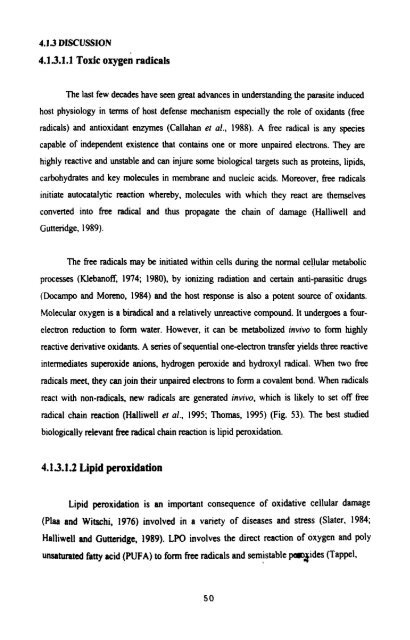effect of infection of the filarial parasite brugia malayi - Pondicherry ...
effect of infection of the filarial parasite brugia malayi - Pondicherry ...
effect of infection of the filarial parasite brugia malayi - Pondicherry ...
Create successful ePaper yourself
Turn your PDF publications into a flip-book with our unique Google optimized e-Paper software.
4.1.3 DISCUSSION<br />
4.1 3.1.1 Toxic oxygen radicals<br />
The last few decades have seen great advances in understanding <strong>the</strong> <strong>parasite</strong> induced<br />
host physiology in t m <strong>of</strong> host defense mechanism especially <strong>the</strong> role <strong>of</strong> oxidants (free<br />
radicals) and antioxidant enzymes (Callahan et al., 1988). A free radical is any species<br />
capable <strong>of</strong> independent existence that contains one or more unpaired electrons. They are<br />
highly reactive and unstable and can injure some biological targets such as proteins, lipids,<br />
carbohydrates and key molecules in membrane and nucleic acids. Moreover, free radicals<br />
initiate autocatalytic reaction whereby, molecules with which <strong>the</strong>y react are <strong>the</strong>mselves<br />
converted into free radical and thus propagate <strong>the</strong> chain <strong>of</strong> damage (Halliwell and<br />
Guneridge, 1989).<br />
The free radicals may be initiated within cells during <strong>the</strong> normal cellular metabolic<br />
processes (Kleban<strong>of</strong>f, 1974; 1980), by ionizing radiation and certain anti-parasitic drugs<br />
(Docampo and Moreno, 1984) and <strong>the</strong> host response is also a potent source <strong>of</strong> oxidants.<br />
Molecular oxygen is a buadical and a relatively unreactive compound. It undergoes a four-<br />
electron reduction to form water. However, it can be metabolized inviw to form highly<br />
reactive derivative oxidants. A series <strong>of</strong> sequential one-electron transfer yields three reactive<br />
intermediates superoxide anions, hydrogen peroxide and hydroxyl mhcal. When two free<br />
radicals meet, <strong>the</strong>y can join <strong>the</strong>ir unpaired electrons to form a covalent bond. When radicals<br />
react with non-radicals. new radicals are generated invivo, which is likely to set <strong>of</strong>f free<br />
radical chain reaction (Halliwell et al., 1995; Thomas, 1995) (Fig. 53). The best studied<br />
biologically relevant fra radical chain reaction is lipid peroxidation.<br />
4.13.1.2 Lipid peroddation<br />
Lipid peroxidation is an important consequence <strong>of</strong> oxidative cellular damage<br />
(Plea and Witschi, 1976) involved in a variety <strong>of</strong> diseases and stress (Slater, 1984;<br />
Halliwcll and Guttnidge, 1989). LPO involves <strong>the</strong> direct reaction <strong>of</strong> oxygen and ply<br />
unsaturated fatty acid (PUFA) to form fm radicals and semistable -ides (Tappel,

















